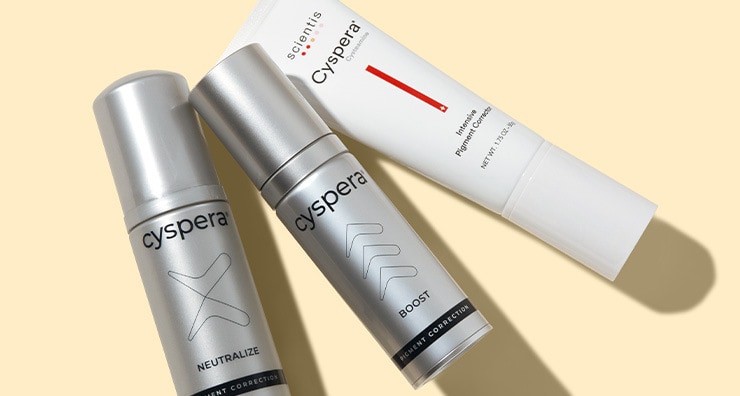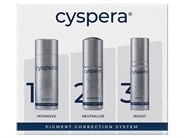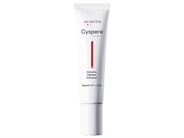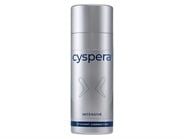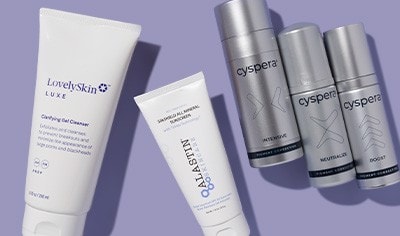When even-looking skin is your goal, having hyperpigmentation stand in your way can be frustrating. Thanks to the new Cyspera Intensive System by Swiss company Scientis, patients with skin discoloration issues now have a treatment option that’s fast-acting and safe to use. “Hyperpigmentation is a challenging condition to treat, so I’m thrilled to have a new tool in my toolkit to help my patients,” says Dr. Joel Schlessinger, a board-certified dermatologist as well as Mohs surgeon and cosmetic surgeon. “The science behind this product line is really exciting.” Ready to learn more? With the help of Dr. Schlessinger, we will answer some frequently asked questions, including:
The Cyspera Intensive System—a three-step routine that includes a pigment corrector, cleanser and moisturizer—is good for treating all kinds of hyperpigmentation, including solar lentigo (dark spots from sun exposure), melasma, post-acne marks and hyperpigmented scars. These kinds of hyperpigmentation occur as a result of excess melanin production in your skin.

The system works quickly and effectively to improve the appearance of these types of discoloration. “What’s really exciting about this system is how quickly clinical study participants saw a visible improvement in their skin,” Dr. Schlessinger says. “Treating hyperpigmentation is often a long game, and though you do need to be diligent about using this system every day in order for it to work, it’s encouraging for patients to start seeing results within just a few weeks.”
You can expect to start to see some visible improvement in hyperpigmentation after two weeks of use. In clinical studies, 100% of participants noticed that their hyperpigmentation had started to fade within four weeks.
The innovative complex behind Cyspera’s powerful results is called the Cysteamine Isobionic-Amide Complex. This complex has three key ingredients: cysteamine (which helps even out skin tone by reducing melanin production), Isobionic-Amide (a more powerful form of niacinamide that helps lighten pigment in the skin’s corneal layer) and alpha hydroxy acids, which create the appropriate pH level for cysteamine to penetrate your skin.
In a double-blind clinical trial, Cyspera’s system was proven to be just as effective in treating melasma as Tri-Luma, a topical prescription treatment that contains hydroquinone, tretinoin and a corticosteroid. “Tri-Luma has been considered a gold standard treatment for hyperpigmentation issues such as melasma, however it has its limits and it’s not without risk,” Dr. Schlessinger says. “One major side effect of Tri-Luma is severe sun sensitivity, and it’s not approved for long-term use, or for people with darker skin tones such as Fitzpatrick types V and VI.”
Cysteamine, one of the key ingredients in Cyspera’s system, is an antioxidant found naturally in the body that can be safely used on a long-term basis. It also can be used on all colors of skin, including darker tones. “The fact that cysteamine can be used on a long-term basis is really exciting, and especially great for patients with melasma, which is a chronic condition that really requires lifelong treatment to maintain results,” Dr. Schlessinger says.
The Cyspera Intensive System has three steps: Intensive, Neutralize and Boost. Here are some tips for first-timers when it comes to using Cyspera’s system on your face:
Always start the system with unwashed skin.
Use the system once daily, in the morning or in the evening.
It’s not a spot treatment, so you’ll want to apply all three products to your entire face. You can also use it on your neck and decolletage.
After using the system daily for sixteen weeks, you can transition to using it twice weekly for maintenance.
Ready to learn more about the products that make up the three-step system?

The first step is the [Intensive Pigment Corrector, a cream-based treatment that helps improve the appearance of uneven skin tone with the Cysteamine Isobionic-Amide Complex. Unlike other skin treatments that are meant to be applied after cleansing, you’ll apply a thin layer of this cream to unwashed skin. If you’re using the system in the morning, that means it will be your very first step after waking up. If you’re using it in the evening, you can apply it right over the sunscreen or makeup you’ve worn all day. If you forget and washed your face first, you’ll want to wait at least one hour before starting the first step.
The second step is Neutralize, which is your cleansing step. This gentle cleanser neutralizes the active ingredients in the Intensive step with a L-Arginine complex and cleanses your skin with a mild surfactant. It also contains lactobionic acid, which helps prepare your skin for the next step, Boost.
Your final step is Boost, the system’s multitasking moisturizer. This cream plays a key supporting role in the three-step system, but it can also be used alone as well for discoloration-improving and anti-aging benefits. It features Isobionic-Amide—a stronger version of niacinamide that’s proprietary to Cyspera—to help reduce pigment formation, smooth fine lines, reduce acne and soothe skin irritation.
It also contains a small amount of retinol to help accelerate cellular turnover. However, it’s not a high enough concentration to cause sun sensitivity. Cyspera’s entire system is not phototoxic, meaning you can use it year round regardless of sun exposure. “Of course, wearing a broad-spectrum sunscreen daily and reapplying it regularly is a good practice to prevent cancer risk regardless of what skin care system you’re using,” Dr. Schlessinger says.
The Cyspera Pigment Correction System was created for use on your face, neck and decolletage, so to treat hyperpigmentation on your body, you’ll want to adjust your approach. To cover larger areas of skin on your body, you can use Cyspera Intensive Pigment Corrector for a fifteen-minute treatment, followed by a gentle body cleanser of your choice.
Another option is Cyspera Intensive Pigment Corrector - Original Formula. This is Cyspera’s original formula pigment corrector that comes in a larger tube and features a less intense concentration of cysteamine. In clinical trials, subjects experienced a 67% reduction of dark spot color intensity after sixteen weeks of use.
Fun fact: Cysteamine was first discovered by pigmentation researchers back in the 1960s. That said, it was slow to come to market in topical hyperpigmentation treatments because of its unpleasant, sulfur-like odor. “Prescription cysteamine cream has been available for years, but few patients can tolerate using it because of the smell. It literally stinks,” Dr. Schlessinger says. “However, Cyspera has figured out how to formulate their cysteamine products so that the scent is a lot easier to tolerate. It might remind you of hair removal creams or a salon perm, and it will only be on your skin for about fifteen minutes.” Once you wash it off, the scent will dissipate.
Cyspera is safe to use on all skin tones and types, including sensitive skin. If your skin tends to be reactive to new products or you have a skin condition such as rosacea, eczema or psoriasis, Cyspera recommends using the pigment corrector step (either Cyspera Intensive Pigment Corrector or Cyspera Intensive Pigment Corrector - Original Formula) for five minutes at first. Over the first week of use, you can work your way up to leaving it on your skin for the full fifteen-minute treatment time.
If you’re using any acne treatments or anti-aging skin care regimens with active ingredients that can cause skin irritation—such as benzoyl peroxide, retinol or high concentrations of glycolic acid or salicylic acid—Cyspera recommends putting those on pause for the first two weeks you start using their system. After that waiting period, you can introduce them back into your routine. If your skin care routine includes retinol, Cyspera recommends using their system for your morning routine and your retinol treatment in the evening.
Watch our how-to video on how to use Cyspera for discoloration, dark spots and more.


